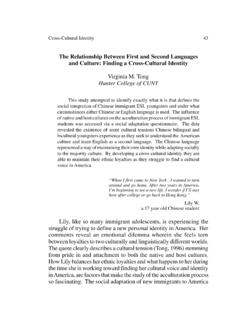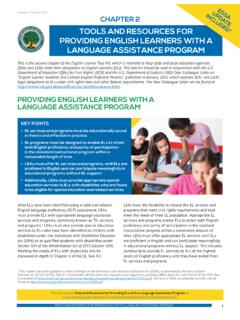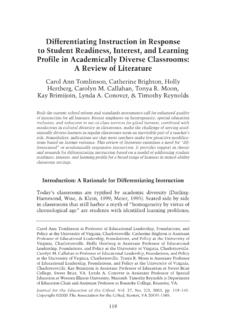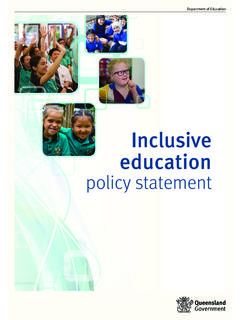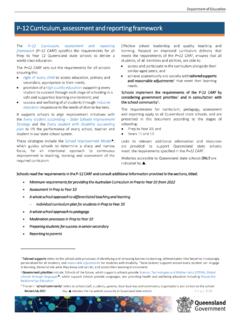Transcription of Preserving Home Languages and Cultures in the Classroom …
1 Preserving home Languages and Cultures in the Classroom 6/4/09 5:06 PM. Directions in language & Education National Clearinghouse for Bilingual Education No. 13, Spring 1999. Preserving home Languages AND Cultures IN THE. Classroom : CHALLENGES AND OPPORTUNITIES. by Lourdes D az Soto, Jocelynn L. Smrekar, and Deanna L. Nekcovei Patricia Anne DiCerbo, Editor Introduction Decades of research document the powerful academic and socio-affective benefits of a strong home language base and affirmation of home language and culture as a valuable resource (Soto, 1998). Yet policymakers across America continue to consider ways of eliminating diverse Languages and Cultures by proposing learning environments where English is the only language of instruction and culture is a minor issue.
2 Examples of the political pressures affecting our educational system can be seen in the passage of California's Proposition 227, "English for the Children," earmarked at eliminating bilingual education programs; in the Wall Street Journal (April 10, 1996) where anti-bilingual advocates call themselves "bilingual education abolitionists"; in a Texas courtroom where the home language issue became a child custody issue (NY Times, August 30, 1995); and in the Congress where English-only legislation continues to be debated. For educators hoping to instill respect for cultural and linguistic diversity through bilingual and multicultural content, this climate of controversy offers both challenges and opportunities. What are the implicit challenges (daily realities) and opportunities (practical implications) of incorporating language and culture in today's classrooms?
3 This article explores these issues as they relate to culturally and linguistically diverse language learners, first describing the daily realities faced by teachers, students, families and communities, and then offering practical suggestions for all Classroom educators. The Challenges: Daily Realities The increased linguistic and cultural diversity in the American Classroom is a reality that many educators feel compelled to address. Demographic data from the Census show that, as of 1990, 14 percent of all children aged 5 to 17 (about million) were reported as not speaking English at home . Moreover, the number of school-age children who did not speak English at home had increased significantly over the file:///Users/morganenriquez/Desktop/unt itled%20 Page 1 of 8.
4 Preserving home Languages and Cultures in the Classroom 6/4/09 5:06 PM. previous decade (National Association for Bilingual Education, 1992). Similarly, recent state-reported enrollment figures indicate that the number of English language learners in grades K-12 increased by almost 2 million during the ten year period between 1986-87 and 1996-97, from 1,553,918 to 3,405,915 (Macias, 1998). It is evident from these trends that educators will continue to face daily realities involving the interrelated issues of language and culture . Yet, the fact that so many children in our classrooms represent multiple Languages and multiple Cultures is not a grim reality offering only challenges, but rather a unique opportunity to exchange valuable wisdom among learners, families, educators, and communities.
5 Nor does such diversity threaten the cohesiveness of our nation and its democratic ideals; the diverse intergenerational wisdom shared by culturally and linguistically diverse families can support and strengthen America's goals. To this end, educators can choose to affirm, acknowledge, and respond to the importance of children's home Languages and Cultures (NAEYC, 1996). Challenges and opportunities arise from multiple levels of the surrounding environment, levels which can be likened to different perspectives on the part of each player (Bronfenbrenner, 1989). For our purposes, the players are the teachers, children, families, and communities that make up a school or district. The following vignettes and discussion will help to illustrate the multiple experiences of these different groups.
6 Player 1: The Teachers An early education center in an urban East Coast community serves over 150 linguistically and culturally diverse preschool children. The center's lead teacher voiced these concerns: We service very young children who are either still learning their native language , who are mostly English speakers, or are children who seem to lack dominance in any language . At our last staff meeting, we struggled with the language issue because it was not clear to us how we should proceed. As the staff struggled with finding an effective approach for their diverse students, they ultimately asked parents and other family members what they thought was the best way to teach second language learners. While most were ambivalent as to the appropriate method, every family wanted to do what was best for their children.
7 One Asian grandmother stated, for instance, "I would like all children to learn English quickly." Yet, she was cautious and concerned when she recalled how the family lost the ability to communicate with their teenage children. From experiences such as the one described above, teachers are learning that an important step in teaching language learners is to allay concerns that they will not learn English quickly enough or succeed academically if they continue to speak their native language at home . The reverse is actually true (Collier &. Thomas, 1989; Cummins, 1981) children who have learned concepts at home in their first language can readily transfer this knowledge to the second language . The major challenge for teachers and families is to work together to address the combined issues of language shift and lack of respect for home Languages .
8 In the vignette above, teachers and parents responded to the challenge by continuing the dialogue and implementing a curriculum that reflected their unique community of Languages and Cultures . Player 2: The Children Young children are caught in the often confusing political and policy making decisions of adults who find it difficult to respect home Languages and home Cultures . A Spanish-speaking child about to enter kindergarten recently asked: file:///Users/morganenriquez/Desktop/unt itled%20 Page 2 of 8. Preserving home Languages and Cultures in the Classroom 6/4/09 5:06 PM. Do you know if I can speak Spanish in school? Marcy told me that if you use Spanish words in teacher punishes you. She said three `Mejicanos'. could not go out to because they kept forgetting.
9 Can you find out if I will be punished too? Unfortunately, accounts of children being singled out and punished for speaking their native language have been reported by educators across the country. The practice of punishing children in response to speaking a language other than English does not consider their backgrounds and experiences (Bredekamp & Coppolo, 1997). In addition, punishing children for home language use is a violation of their linguistic human rights (Skutnabb-Kangas & Phillipson, 1995). Educators are in the position of being able to give native language speaking children support and encouragement as they are attempting to make sense of their world while learning to communicate in the second language . Player 3: The Families Linguistically and culturally diverse families also struggle with issues of language shift and lack of respect for home Languages and Cultures (Soto, 1997).
10 One poignant example involves a Latino family who, like many other families, received the following advice from a well-intentioned Kindergarten teacher: La missy nos dijo (the teacher told us) that we should speak English-only at home . She warned us that if Graciella could not speak English (fluently) by the end of the year, she would be held back. We told Abuelita (Grandmother) not to talk to Graciella because she would only confuse her. But Graciella spends so much time with Abuelita that we wonder if that is such a good idea. What do you suggest we do? Giving advice to speak English-only at home can have tragic outcomes for culturally and linguistically diverse families (Wong Fillmore, 1991). home Languages and home Cultures are at the heart of the communicative process for families; thus, teachers who provide advice that is congruent with research evidence, mainly that a strong home language base actually facilitates children's second language learning, are in many ways providing a gift to their students.
